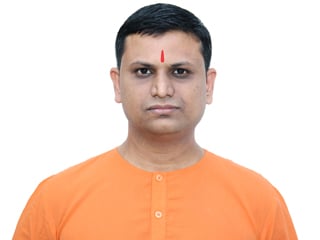
Dhanushkodi is a place of pilgrimage of Hindus located in the south-eastern tip of Bharat. It is the origin of the sacred Ramsetu (Bridge of Shrirama). In the past five decades this Hindu place of pilgrimage has been reduced to a devastated town. On December 22, 1964 a cyclone destroyed this city. Instead of its restoration the Government defamed it by declaring it a ‘ghost town’. Now to commemorate 50 years of this incident leaders of Hindu activist organisations from West Bengal, Assam, Maharashtra, Karnataka and Tamilnadu visted Dhanushkodi on a study tour. The fearsome truth which we discovered about Dhanushkodi is being revealed through this article.
Sweet water at Dhanushkodi, a natural wonder !
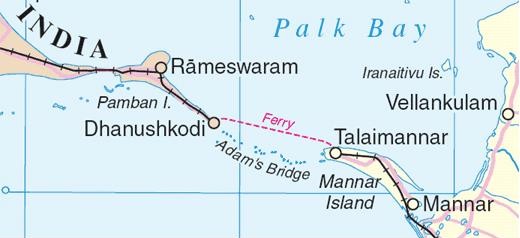
The Indian Ocean to the south of Dhanushkodi appears bluish coloured whereas the Bay of Bengal to its north is brownish black in colour. The distance between these two oceans is less than a kilometre. The water from both is salty. Yet when a 3 feet pit is dug in the soil at Dhanushkodi the water there is found to be sweet. Is this not a marvel of nature ?
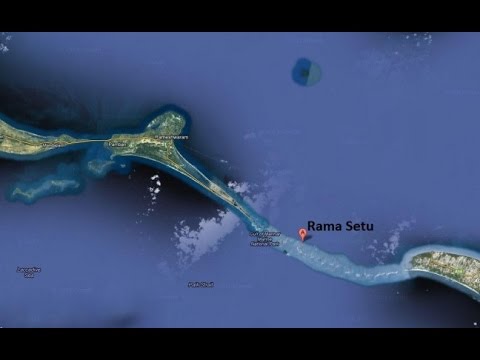
Aerial view of Ramsetu (a picture taken by NASA using a satellite)
Geography of Dhanushkodi
The place of pilgrimage of Rameshwaram lies on the east coast of the state of Tamilnadu. Dhanushkodi is a town situated 11 kilometres to the south of Rameshwaram. Srilanka is approximately 18 miles (30 kilometres) from here. At the sacred confluence of the Bay of Bengal (Mahodadhi) and the Indian Ocean (Ratnakar) is Dhanushkodi, a place just 50 gaj (a measure of distance – approximately 150 feet) broad and covered with sand.
Religious greatness of Rameshwaram and Dhanushkodi

The spiritual importance that is accorded to Kashi in North Bharat, the same is accorded to Rameshwaram in South Bharat as well. Rameshwaram is one of the holy pilgrimage places to visit in Char Dham yatra. As per Scriptures only after bathing at the confluence of the Bay of Bengal and Indian Ocean at Dhanushkodi and consecrating Deity Rameshwar with Holy water from the Ganga, a pilgrimage to Kashi is said to be complete.
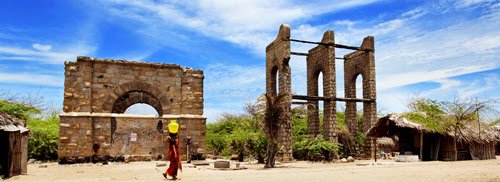
History of Dhanushkodi and the ancient Ramsetu
The part of the land before the Ramsetu is called as Dhanushkodi (kodi means tip of the bow) because 17.5 lakh years ago Shriram has earmarked this place to build a bridge to Ravan’s Lanka (Srilanka) with His ‘Kodanda’ bow. A row of islands of big boulders is visible in the remnants of the Ramsetu even today. The Ramsetu is an architectural wonder of Nal and Neel. A detailed description given in the Valmiki Ramayan states that its width is 1/10th of its length. In reality after direct measurement its width is 3.5 kilometres and length 35 kilometres. For generations, Hindus are well versed with the contribution of the tiny squirrel towards building of the bridge and that of the boulders floating on the water due to the Name of Shriram engraved on it.
Dhanushkodi and Bibheeshan – a devotee of Shrirama
Prior to the war between Shriram and Ravan, Bibheeshan, brother of Ravan, had surrendered unto Deity Ramachandra in the town of Dhanushkodi. After the battle in Srilanka concluded, Shriramachandra coronated Bibheeshan as the emperor of Srilanka. At that time Bibheeshan expressed the fear that brave and valorous kings would use the Ramsetu and invade Srilanka repeatedly and destroy its independence so he requested Shriram to demolish the bridge. In response to his wholehearted prayer Ramachandra released an arrow onto the Ramsetu and submerged it in water. Hence it went 2 to 3 feet below the water level. Even today if someone stands on Ramsetu, there the water level upto the one’s waist.
The Setusamudram project destroying the Ramsetu
The anti-Hindu Congress Government at the Centre had hatched the conspiracy of demolishing the ancient bridge for the purpose of the ‘Setusamudram Shipping Canal Project’ meant for commercial benefits. This project is a direct attack on the faith of Hindus. After about 24% of the bridge was demolished, the Supreme Court gave a stay order for the project. Till then one fourth of the strong Ramsetu had been drilled. Thus the huge boulders from it were completely crushed. Even today pieces of these boulders are seen floating in the Indian Ocean and Bay of Bengal and sometimes appear in the nets of fishermen here. Some people are seen selling these boulders in Dhanushkodi or Rameshwaram. Thus the Congress Government is guilty of destroying places of historical and religious importance not only to the entire human race but also to history. This sin is certainly not forgivable !
Prior to 1964 Dhanushkodi was a big town !
During the British rule Dhanushkodi was a big town and Rameshwaram, a small village. There were boats for to and fro travel to Srilanka. Those days there was no need for a passport to enter Srilanka and the ticket from Dhanushkodi to Thalaimannar (Srilanka) would cost just 18 rupees. Even trade flourished through these boats. Swami Vivekanand who attended the Religious Conference in America in 1893 returned to Bharat via Srilanka and in 1897 alighted at Dhanushkodi. In 1964 it was a well-known tourist spot and place of pilgrimage. There were hotels, garment stores and dharmashalas (Caravanserai) for devotees here. Besides there was a shipbuilding centre, a railway station, a small railway hospital, a post office and small Government offices such as fisheries department situated here.
Before the cyclone in 1964 between Chennai and Dhanushkodi, there used to be a rail service from Madras Egmore known as Boat mail. It was useful for travellers going to Srilanka via ferryboat.
The cyclone of 1964 destroys Dhanushkodi
The cyclone in 1964 destroyed Dhanushkodi. On December 17, 1964 the centre of the cyclone was 5 degrees to the east of the sea in south Andaman. On December 19, 1964 it assumed the form of a huge cyclone. On the night of December 22, 1964 it moved with a speed of 270 kilometres per hour and finally hit the coast of Dhanushkodi. The 20 feet high tidal wave which struck Dhanushkodi town during the cyclone attacked the town thorough the sacred confluence on its east and razed the entire town completely.
A memorial has been constructed on the Dhanyushkodi bus bay as a tribute to the victims there. Inscribed in it is –‘The cyclone which came with high velocity winds on 22nd December 1964 caused tremendous loss and razed the town completely.!’
A railway bridge and train collapse in the cyclone
On the unfortunate night of December 22, 1964 at 11.55 p.m. train Pamban–Dhanushkodi Passenger train no 653 arrived at the Dhanushkodi railway station (it had arrived from Pamban with 110 passengers and 5 railway employees) and became a victim of this tidal wave.The train was a few metres away from the Dhanushkodi railway station. The entire train with 115 passengers was washed away and the rail route from Pamban to Dhanushkodi was destroyed. Later the rail route got destroyed further and after sometime was completely buried in sand.
Water flowing with high speed stopped near the Rameshwaram temple
The cyclone moved further till Rameshwaram with tidal waves of 8 feet height. Approximately more than 1800 people from here perished in the cyclone but the locals say that the casualties went upto 5000. Houses and all belongings of residents of Dhanushkodi were destroyed, only the ruins remained. Wind blew at a speed of 10 kilometres per hour and razed the entire town completely but eye witnesses say that the water which was flowing with such high speed stopped at the main door of the Rameshwaram temple. So those who had taken refuge in the temple were saved from the cyclone.
Lone survivor of the cyclone
In the cyclone of 1964 everyone from the town of Dhanushkodi were killed. The only survivor was Kaliyaman. He was saved because he swam in the sea. The Government honoured him by naming the village adjoining Dhanushkodi, Nichal Kaliyaman (nichal means swimmer).
The Government declares Dhanushkodi as a ‘ghost town’
Soon after this calamity the Madras Governemnt declared on All India Radio that this was a ‘ghost town’ and prohibited citizens from residing there. A place without any human population is called a ghost town. Now only some fishermen and traders are allowed to go there for business but they too have to return before 7 p.m.
Town of sand and ruins
Now the town of Dhanushkodi is completely covered with sand (it is interspersed with trees and sea water). Aerial views of the town show only sand with ruins in between. Remnants of the shipbuilding centre, railway station, post office, hospital, police and railway residential quarters, school, temple, church etc. are clearly visible.
Neglecting the development of Dhanushkodi
Devotees going to Dhanushkodi are advised to travel there during the day and to return by sunset because an entire 15 kilometre stretch of road has no human inhabitation and is scary. More than 500 pilgrims visit Dhanushkodi everyday especially on festivals and on pournima (Full moon days) but have no alternative but to commute in private vehicles with drivers charging exorbitantly. Pilgrims travelling to Rameshwaram from all over the country had appealed for a railway service after which the Southern Railway Ministry had presented a proposal for a railway track of 16 kilometres from Rameshwaram to Dhanushkodi but till date this project has been neglected.
Vision (Darshan) of Ramsetu a rarity due to an improper Government policy
Devotees from all over Bharat come to Dhanushkodi to get a glimpse of the sacred Ramsetu and then discover that they require custom clearance to be able to do it. The customs office is in Rameshewaram. Devotees come here from Rameshwaram through the sand (no tar roads) and sometimes through a cumbersome sea journey. Making them return (18 kilometres) to Rameshwaram to get this permission is indeed ridiculous ! Why does the Government not open a customs office in Dhanushkodi ? Due to this issue, despite visiting Dhanushkodi 90% pilgrims are unable to see the Ramsetu.
The link with Srilanka severed
Since there are disputes about the marine border between Bharat and Srilanka, the transport along the sea route between Dhanushkodi and Thalaimannar is closed as a result of which the communication between Hindus from this region with the Hindus in Srilanka has been severed. Formerly every day at 6 p.m. they would bring milk from Srilanka to Bharat and it would be used for consecration on the Rameshwar Shivalinga in the early morning on the following day. This is a very ancient tradition which has ceased due to the marine border issue. Formerly it would take 2 hours to travel a distance of 35 kilometres from Thalaimannar to Dhanushkodi by boat. Now to cover a distance of 500 kilometres from Thalaimannar to Colombo it requires 10 hours. There is a flight service from Colombo to Madurai which takes about an hour. The 200 kilometre journey from Madurai to Rameshwaram takes 4.5 hours by rail or road.
The routeless journey from Rameshwaram to Dhanushkodi is a test for the devotees !
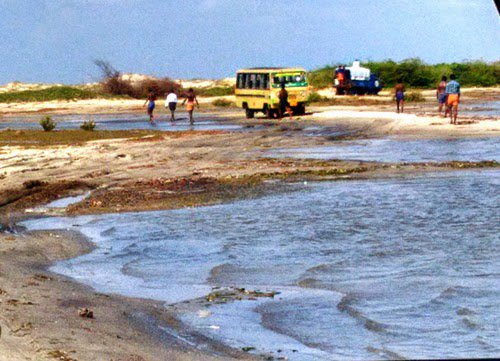
In the present circumstances to reach Dhanushkodi from Rameshwaram you have to cross the sand and sea water on foot or in private vehicles. After visiting Rameshwaram devotees wish to see the Ramsetu in Dhanushkodi. In this 18 kilometre journey there is a tarred road only till Hemarpuram. Beyond that it has to be done through sand or at times through sea water on the coast. There is no road for this 7 km stretch. In spite of being an important place of pilgrimage, it is indeed surprising that no road has been constructed here. Yet facing all hardships devotees travel till Dhanushkodi. Majority of the devotees travel only till Hemarpuram. Because of lack of proper roads, they don’t show courage to travel ahead. Only the courageous devotees try to go upto Dhanushkodi. Every pilgrim visiting this place wonders why a road connecting these two places has not yet been constructed. The secular philosophy of Bharatiya politicians of not giving any importance to religious sentiments of Hindus is visible here as well. This road is essential not just from the viewpoint of religious sentiment but also from the viewpoint of national integration. Millions of Hindus not only from South Bharat, but from North Bharat including Kashmir, North-east Bharat including Assam, East Bharat including Bengal and West Bharat including Mumbai, Gujarat etc. forgetting all differences of caste, language, region etc. going to Kashi, also wish to come to Rameshwaram. Dhanushkodi is a town which will bring about national unity. Why don’t the Tamilnadu and Central Governments construct this small stretch of road to strengthen the national integration ? In metropolitan cities thousands of crores are used to build metro trains. Then why is this road costing just 50 to 60 crore rupees not being constructed ? In Kashmir there was a road from Poonch to Srinagar in Kashmir in the Mughal regime. Referring to this road as a gift from Muslim culture, the Government spent several crore rupees to renovate it, then what is the problem in rebuilding the road which is a symbol of Hindu faith and was destroyed in 1964 ?
True development of places of pilgrimage will occur only in the Hindu nation
Seeing the expanse of Dhanushkodi it became clear as to how politicians from all parties are neglecting Bharatiya places of pilgrimage. Will the nation builder of Bharat who declared Kashi as a smart city give justice to Dhanushkodi that completes the pilgrimage of Kashi ? The insensitivity of Hindus too is a cause for this deterioration. If we Hindus remain insensitive like this then several places of pilgrimage which are prosperous today too will become like Dhanushkodi. Hindus should demand that their places of pilgrimage are developed with amenities such as dharmashalas, roads etc. The only way to achieve this is by establishing a righteous Hindu nation.
– Mr. Chetan Rajhans, Sanatan Sanstha

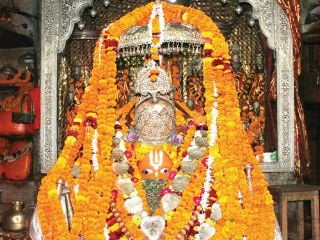 A sacred premises purified by the Holy presence of Prabhu Shri Ramchandra
A sacred premises purified by the Holy presence of Prabhu Shri Ramchandra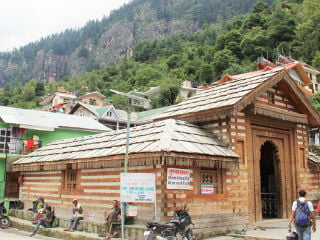 Deity Shri Rama’s Kulaguru (Family Spiritual Master), ‘Sage Shri Vasishtha’s’ place of penance at Manali...
Deity Shri Rama’s Kulaguru (Family Spiritual Master), ‘Sage Shri Vasishtha’s’ place of penance at Manali...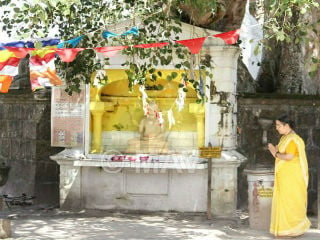 Place where Sitamata had undergone Agni-pariksha for proving her chastity !
Place where Sitamata had undergone Agni-pariksha for proving her chastity !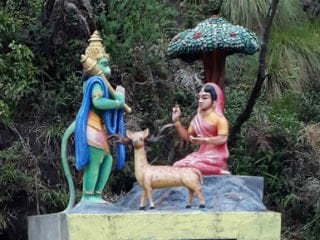 ‘Ashok Vatika’ in Sri Lanka which has been sanctified with visits of Sitamata and Hanuman...
‘Ashok Vatika’ in Sri Lanka which has been sanctified with visits of Sitamata and Hanuman...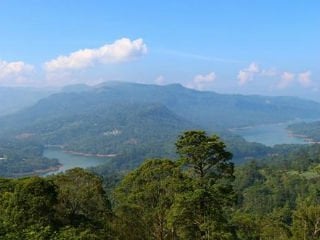 ‘Ramaboda’ and ‘Ravanaboda’ mountains in Sri Lanka are witnesses of ‘Rama-Ravana’ war
‘Ramaboda’ and ‘Ravanaboda’ mountains in Sri Lanka are witnesses of ‘Rama-Ravana’ war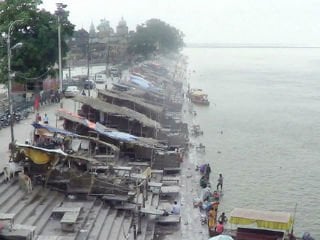 Let us take darshan of places associated with Shriram in Sri Lanka and different parts...
Let us take darshan of places associated with Shriram in Sri Lanka and different parts...